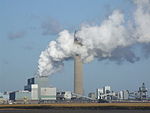RNAS Kingsnorth
Royal Air Force stations in KentRoyal Naval Air Stations in KentSeaplane bases in EnglandSeaplane bases in the United KingdomTransport in Medway ... and 1 more
Use British English from May 2013
RNAS Kingsnorth was a First World War Royal Navy air station for airships, initially operating as an experimental and training station, it later moved on to large scale production of airships. It also provided anti-submarine patrols. A number of experimental and prototype blimps were designed and tested there and until 1916, it was the lead airship training establishment in the Royal Naval Air Service.It was located at the southeastern coast of the Hoo Peninsula in Kent.It is not to be confused with RAF Kingsnorth, a separate airfield in southern Kent under RAF control before and during World War II.
Excerpt from the Wikipedia article RNAS Kingsnorth (License: CC BY-SA 3.0, Authors).RNAS Kingsnorth
Jacobs Lane,
Geographical coordinates (GPS) Address Nearby Places Show on map
Geographical coordinates (GPS)
| Latitude | Longitude |
|---|---|
| N 51.422777777778 ° | E 0.60194444444444 ° |
Address
Jacobs Lane
Jacobs Lane
ME3 9NQ , Hoo St. Werburgh
England, United Kingdom
Open on Google Maps









